1993 CHEVROLET BLAZER transmission
[x] Cancel search: transmissionPage 64 of 386
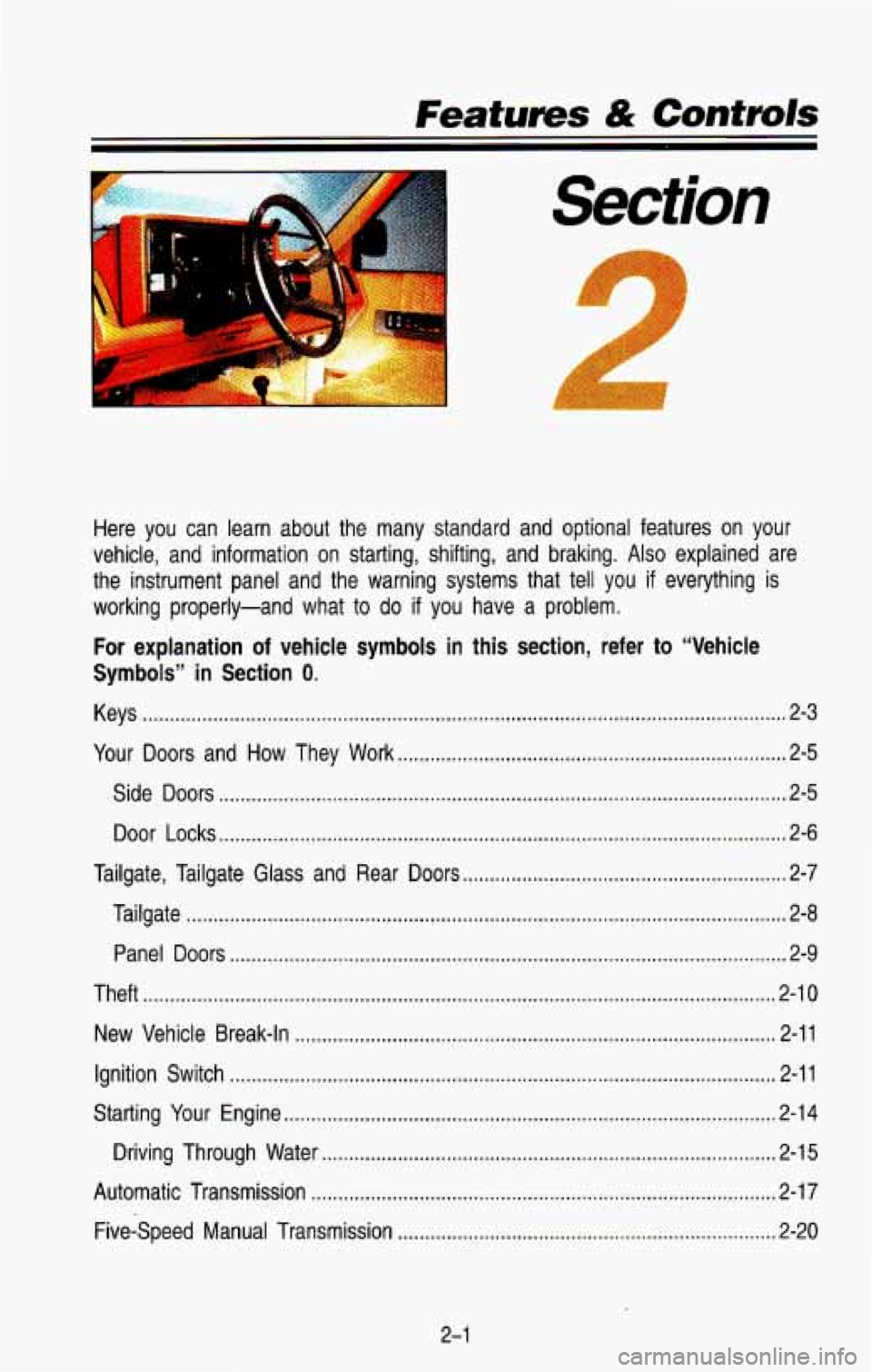
. Featums & Controls
I
Section
Here you can learn about the many standard and optional featur\
es on your
vehicle. and information on starting. shifting. and braking
. Also explained are
the instrument panel and the warning systems that tell you
if everything is
working properly-and what to do if you have a problem
.
For explanation of vehicle symbols in this section. refer to “Vehicle
Symbols” in Section 0 .
Keys ........................................................................\
............................................... 2-3
Your DobrS and How They Work
........................................................................\
2-5
Side Doors
........................................................................\
................................. 2-5
Door Locks
........................................................................\
................................. 2-6
Tailgate. Tailgate Glass and Rear Doors
............................................................ 2-7
Tailgate
........................................................................\
....................................... 2-8
Panel Doors ........................................................................\
............................... 2-9
Theft
........................................................................\
............................................. 2-10
New Vehicle Break-In
........................................................................\
................. 2-11
Ignition Switch
........................................................................\
............................. 2-11
Starting Your Engine ........................................................................\
................... 2-14
Driving Through Water
........................................................................\
............ 2-15
Automatic Transmission
........................................................................\
.............. 2-17
Five-Speed Manual Transmission ...................................................................... 2-20
2-1
Page 73 of 386
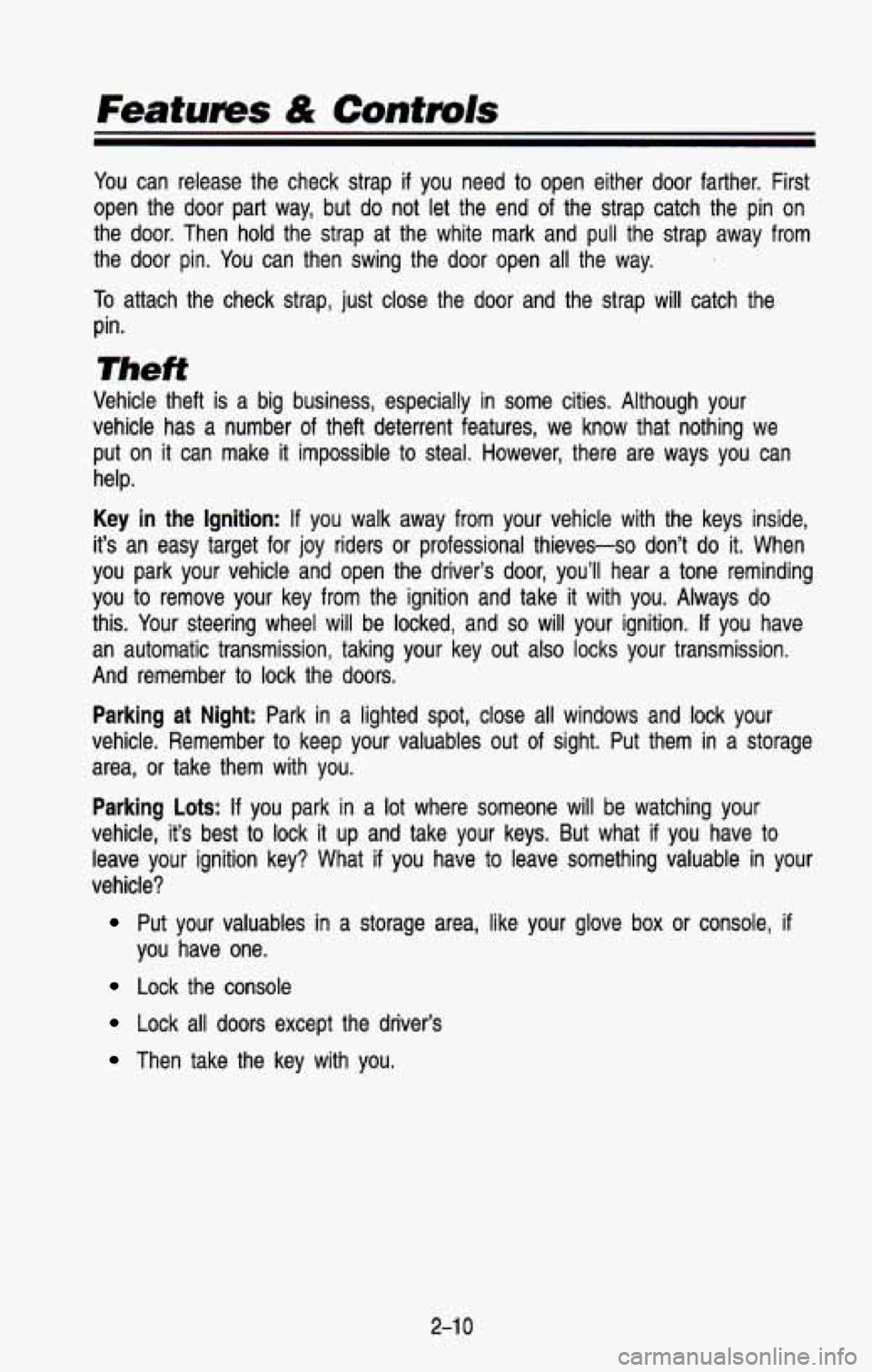
Features & Contmls
You can release the check strap if you need to open either door farther. First
open the door part way, but do not let the end of the strap catch the pin on
the
door. Then hold the strap at the white mark and pull the strap away from
the door pin. You can then swing the door open all the way.
To attach the check strap, just close the door and the strap wil\
l catch the
pin.
Theft
Vehicle theft is a big business, especially in some cities. Although your
vehicle has a number of theft deterrent features, we know that nothing we
put on it can make
it impossible to steal. However, there are ways you can
help.
Key in the Ignition: If you walk away from your vehicle with the keys inside,
it’s an easy target for joy riders or professional thieves-so don’t do it. When
you park
your vehicle and open the driver‘s door, you’ll hear a tone r\
eminding
you to remove your key from the ignition and take it with you. Always do
this. Your steering wheel will be locked, and
so will your ignition. If you have
an automatic transmission, taking your key out also locks your transmission.
And remember to lock the doors.
Parking at Night: Park in a lighted spot, close all windows and lock your
vehicle, Remember to keep your valuables out of sight. Put them
in a storage
area, or take them with you.
Parking Lots: If you park in a lot where someone will be watching your
vehicle, it’s best to lock it up and take your keys. But what
if you have to
leave your ignition key? What
if you have to leave something valuable in your
vehicle?
Put your valuables in a storage area, like your glove box or console, if
you have one.
Lock the console
Lock all doors except the driver’s
Then take the key with you.
2-1 0
Page 75 of 386
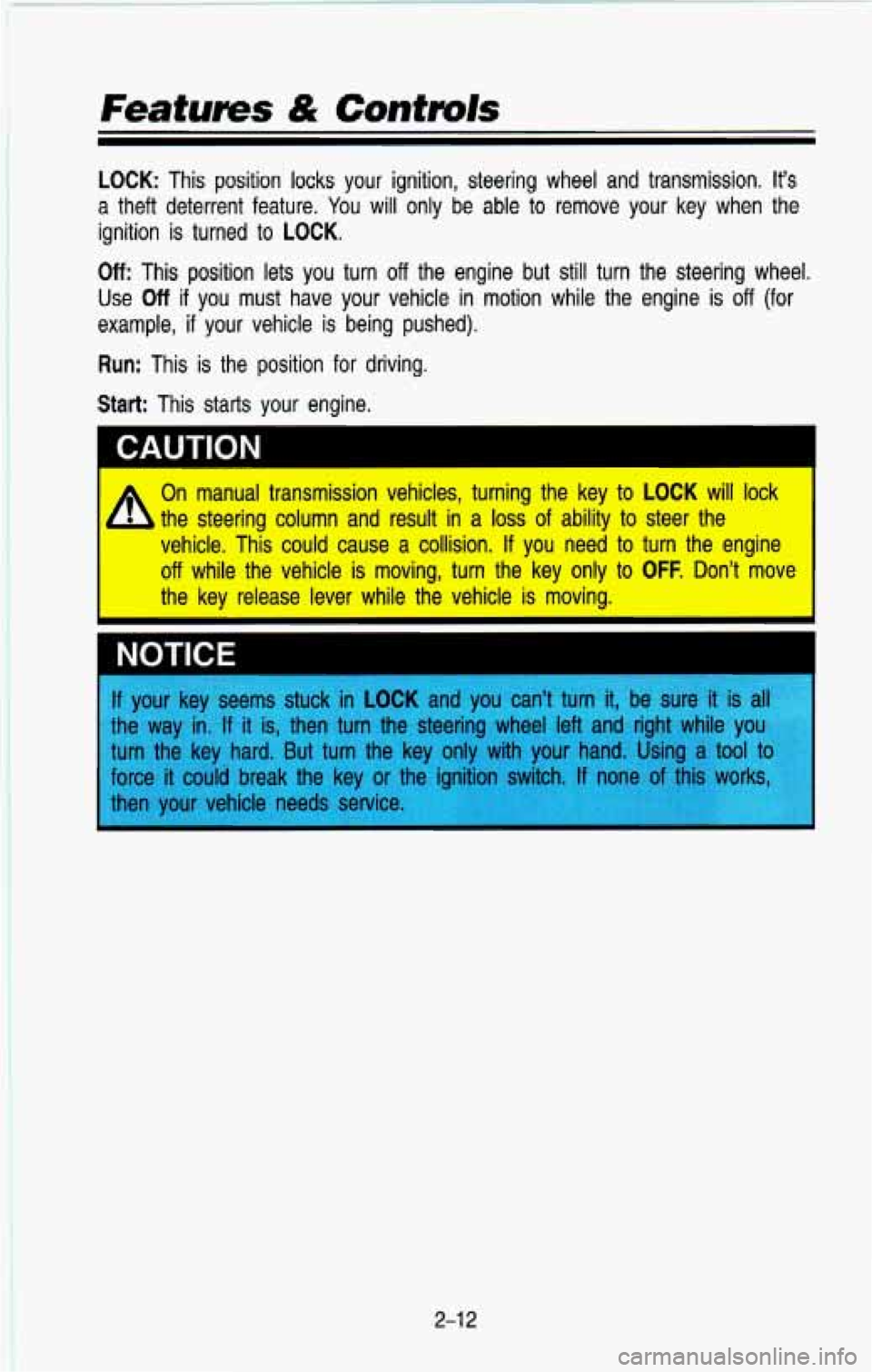
Features & Controls
LOCK: This position locks your ignition, steering wheel and transmission. it's
we your key when the a theft deterrent feature. You will only be able to rem(
ignition is turned to
LOCK.
Off: This position lets you turn off the engine but still
Use
Off if you must have your vehicle in motion while
example,
if your vehicle is being pushed).
Run: This is the position for driving.
Start: This starts your engine. turn the steering wheel.
1 the engine
is off (for
'a
On manual transmission vehicles, turning the key to LOCK will lock
the steering column and result in a
loss of ability to steer the
vehicle. This could cause a collision.
If you need to turn the engine
off while the vehicle is moving, turn the key only to OFF. Don't move
the key release lever while the vehicle
is moving.
I
I
NOTICE
2-1 2
Page 76 of 386
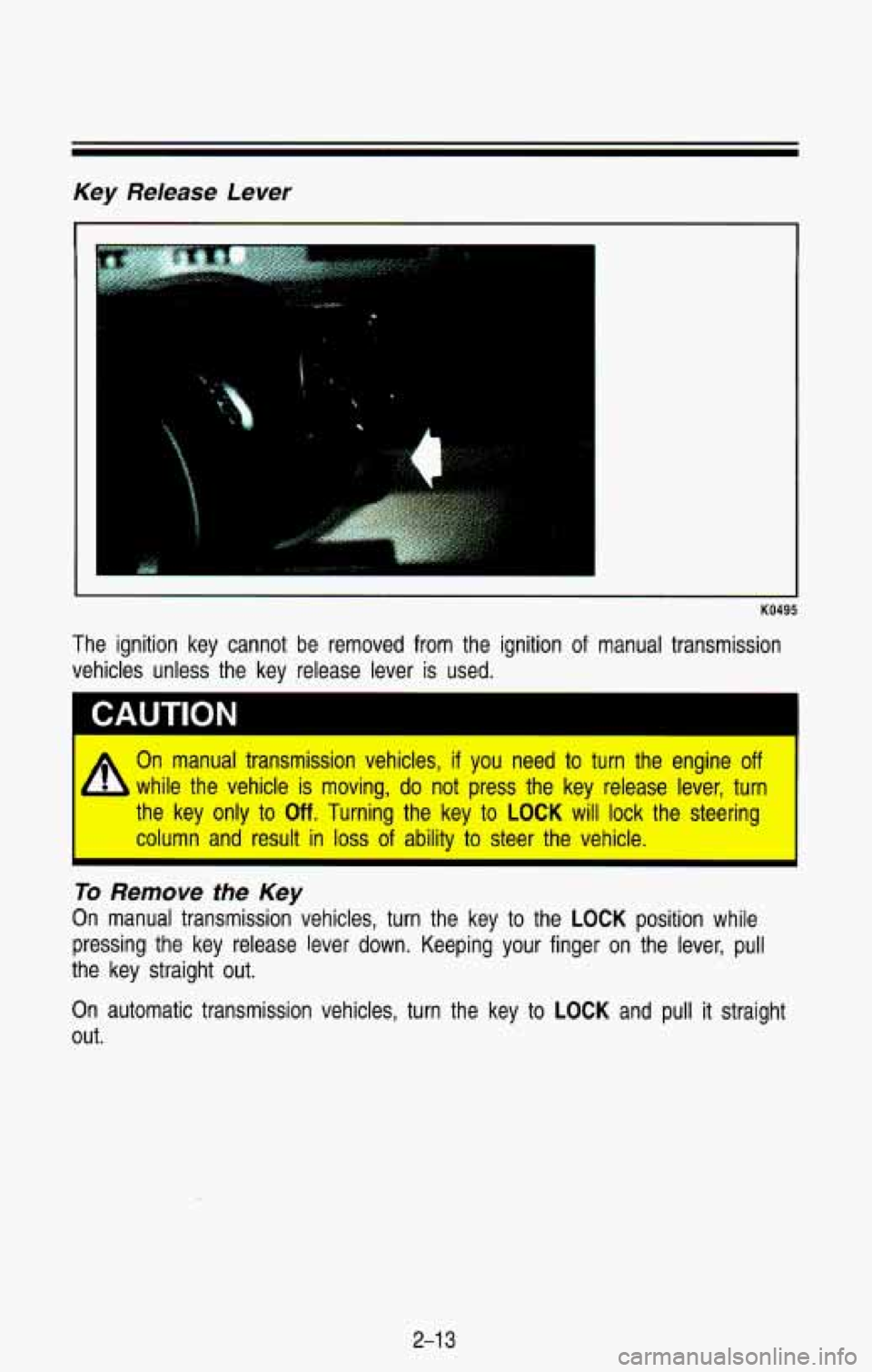
Key Release Lever
I
KO495
The ignition key cannot be removed from the ignition of manual transmission
vehicles unless the key release lever is used.
I
A
On manual transmission vehicles, if you need to turn the engine off
while the vehicle is moving, do not press the key release lever, turn
the key only to
Off. Turning the key to LOCK will lock the steering
column and result in
loss of ability to steer the vehicle. I
I
To Remove the Key
On manual transmission vehicles, turn the key to the LOCK position while
pressing the key release lever down. Keeping your finger on th\
e lever, pull
the key straight out.
On automatic transmission vehicles, turn the key to
LOCK and pull it straight
out.
2-1 3
Page 77 of 386
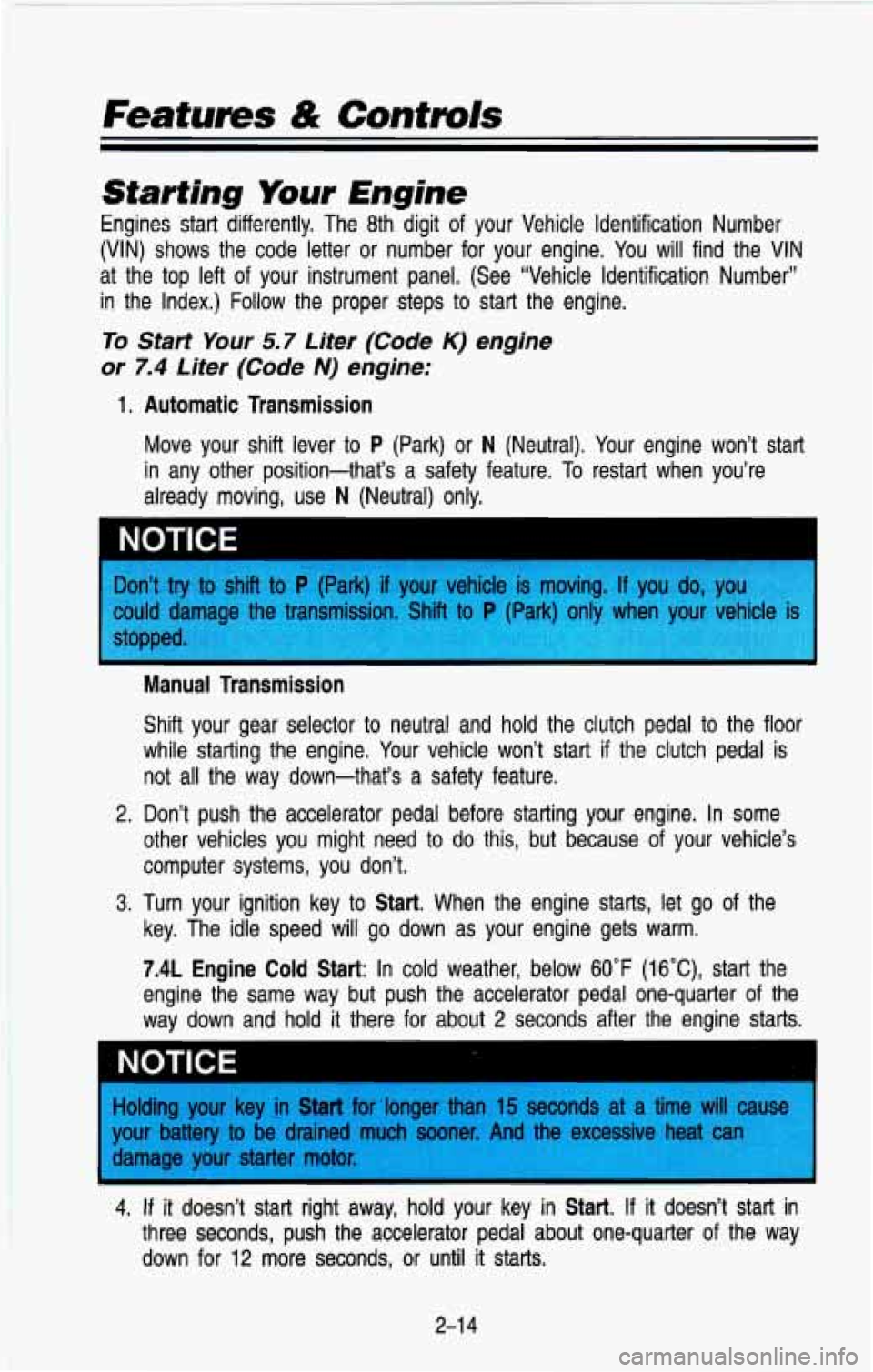
Features & Controls
kmrting Your Engine
Engines start differently. The 8th digit of your Vehicle Identification Number
(VIN) shows the code letter or number for your engine. You
will find the VIN
at the top left of your instrument panel. (See “Vehicle Identification Number\
”
in the Index.) Follow the proper steps to start the engine.
To Start Your 5.7 Liter (Code K) engine
or
7.4 Liter (Code N) engine:
1. Automatic Transmission
Move your shift lever to P (Park) or N (Neutral). Your engine won’t start
in any other position-that’s a safety feature. To restart when you’re
already moving, use
N (Neutral) only.
NOTICE I
Don’t try to shift to P (Park) if your vehicle is moving. If you do, you^^^^
p~&w$gp!
could damaa our P . icle is
stormed
Manual Transmission
Shift your gear selector to neutral and hold the clutch pedal \
to the floor
while starting the engine, Your vehicle won’t start if the clutch pedal is
not
all the way down-that’s a safety feature.
2. Don’t push the accelerator pedal before starting your engine.\
In some
other vehicles you might need to do this, but because of your vehicle’s
computer systems, you don’t.
key. The idle speed will go down as your engine gets warm.
7.4L Engine Cold Start: In cold weather, below 60°F (16°C)’ start the
engine the same way but push the accelerator pedal one-quarter \
of the
way down and hold it there for about 2 seconds after the engine starts.
3. Turn your ignition key to Start. When the engine starts, let go of the
Holding your key in
Start for ‘longer than 15 seconds at a time will cause
your battery to be drained much sooner. And the excessive he
damage
your starter motor.
4. If it doesn’t start right away, hold your key in Start. If it doesn’t start in
three seconds, push the accelerator pedal about one-quarter of the way
down for 12 more seconds,
or until it starts.
2-1
4
Page 81 of 386
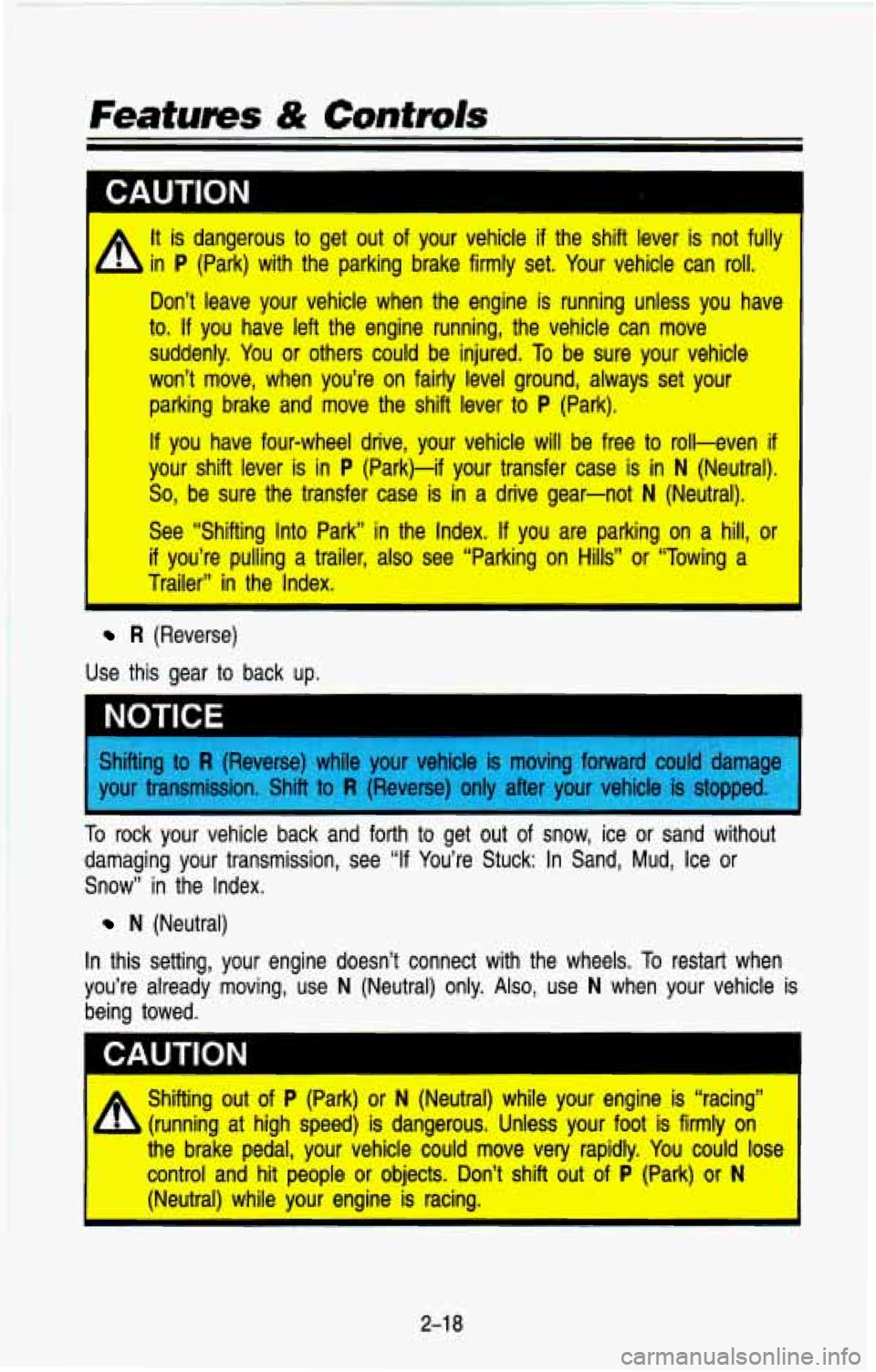
- It is dangerous to get out of your vehicle if the shift lever is not fully
4 in P (Park) with the parking brake firmly set. Your vehicle can roll.
Don’t leave your vehicle when the engine is running unless you have
to, If you have left the engine running, the vehicle can move
suddenly.
You or others could be injured. To be sure your vehicle
won’t
move, wh’en you’re on fairly level ground, always set your
parking brake and move the
shift lever to P (Park).
If you have four-wheel drive, your vehicle will be free to roll-even if
your shift lever is in P (Park)-if your transfer case is in N (Neutral).
So, be sure the transfer case is
in a drive gear-not N (Neutral).
See “Shifting Into Park” in the Index. If you are parking on a hill, or
if you’re pulling a trailer, also see “Parking on Hills’’ or ‘Towing a
Trailer”
in the Index.
R (Reverse)
Use this gear
to back up.
I NOTICE
I!
Shifting to R (Reverse) while your vehicle is moving forward could damage
jour transmission. Shift to R (Reverse) only after your vehicle is stopped.
To rock your vehicle back and forth
to get out of snow, ice or sand without
damaging your transmission, see “If You’re Stuck: In Sand, Mud, Ice or
Snow” in the Index.
N (Neutral)
In this setting, your engine doesn’t connect with the wheels.
To restart when
you’re already moving, use
N (Neutral) only. Also, use N when your vehicle is
being towed.
I CAUTION
Shifting out of P (Park) or N (Neutral) while your engine is “racing”
(run’ning at
high speed) is dangerous. Unless your foot is firmly on
the brake pedal, your vehicle could move very rapidly. You could lose
control and hit people or objects. Don’t shift out of P (Park) or N
(Neutral) while your engine is racing. I
2-1 8
Page 82 of 386
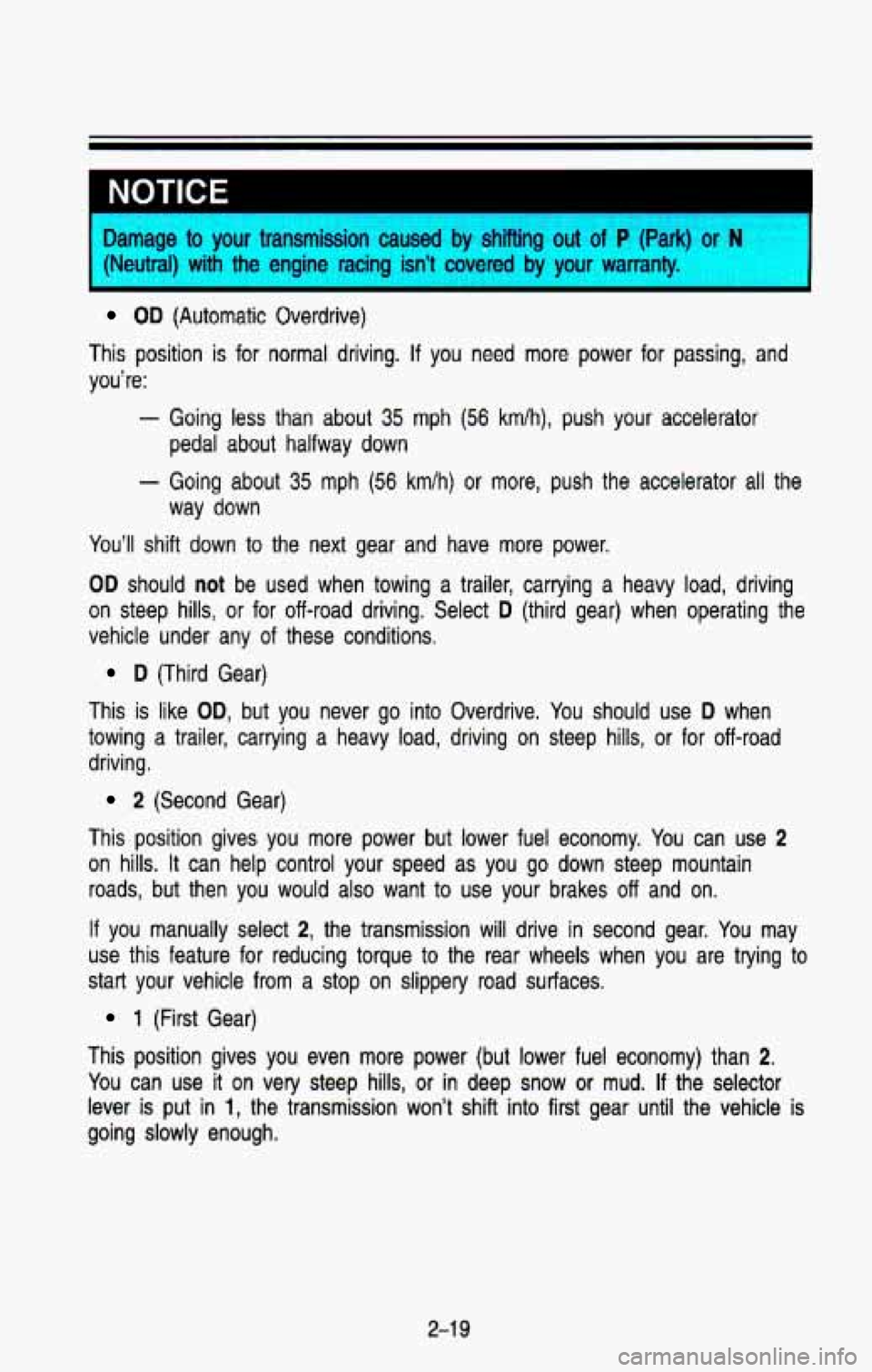
NOTICE
Damage to your transmission caused by shifting out of P (Park) or N
{Neutral) with the engine racing isn’t covered by your warranty.
OD (Automatic Overdrive)
This position is for normal driving.
If you need more power for passing, and
vou’re:
- Going less than about 35 mph (56 km/h), push your accelerator
pedal about halfway down
- Going about 35 mph (56 km/h) or more, push the accelerator all the
way down
You’ll shift down to the next gear and have more power.
OD should not be used when towing a trailer, carrying a heavy load, driving
on steep hills, or for off-road driving. Select
D (third gear) when operating the
vehicle under any of these conditions.
D (Third Gear)
This is like
OD, but you never go into Overdrive. You should use D when
towing a trailer, carrying a heavy load, driving on steep hills, or for off-road
driving.
2 (Second Gear)
This position gives you more power but lower fuel economy. You can use
2
on hills. It can help control your speed as you go down steep mountain
roads, but then you would also want
to use your brakes off and on.
If you manually select 2, the transmission will drive in second gear. You may
use this feature for reducing torque to the rear wheels when you are trying to
start your vehicle from a stop on slippery road surfaces.
1 (First Gear)
This position gives you even more power (but lower fuel economy) than
2.
You can use it on very steep hills, or in deep snow or mud. If the selector
lever is put
in 1, the transmission won’t shift into first gear until the vehicle is
going
‘slowly enough.
2-1 9
Page 83 of 386
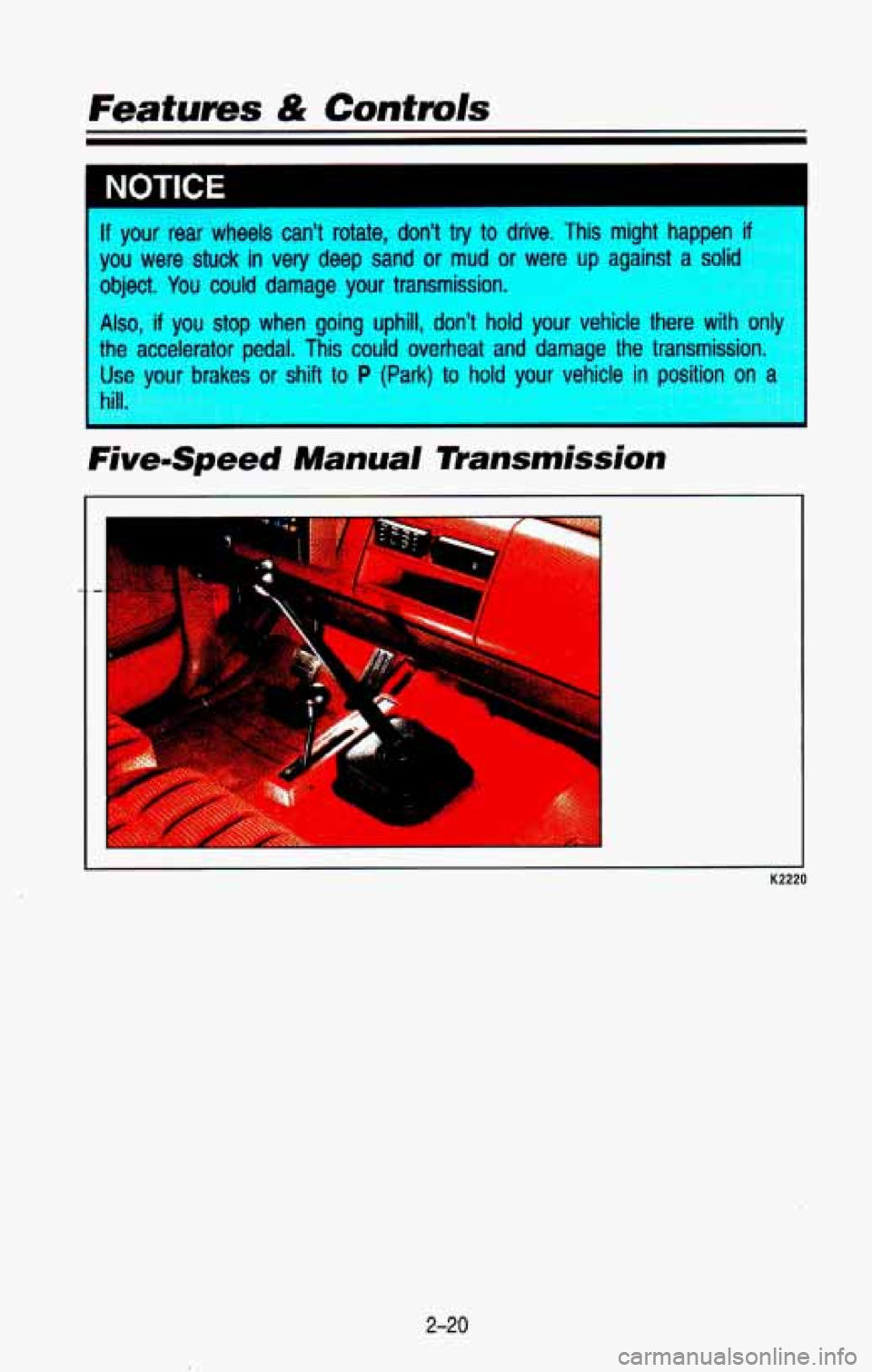
. . -.
1
I lf your rear wheels can’t rotate, don’t try to drive, This might happen if
pu were stuck in very deep sand or mud or were up against a solid
-‘-’ect. You could damage your transmission. *?isgi%
so, if you stop when going uphill, don’t hold your vehicle there wi onl,
:he accelerator pedal. This could overheat and damage the transmission.
Jse your brakes or shift to P (?k) to hold your vehicle in position on a
?ill.
:,e%-=
FivemSpeed Manual 7Pansmission
I
2-20